 Facebook
Facebook
 X
X
 Instagram
Instagram
 TikTok
TikTok
 Youtube
Youtube
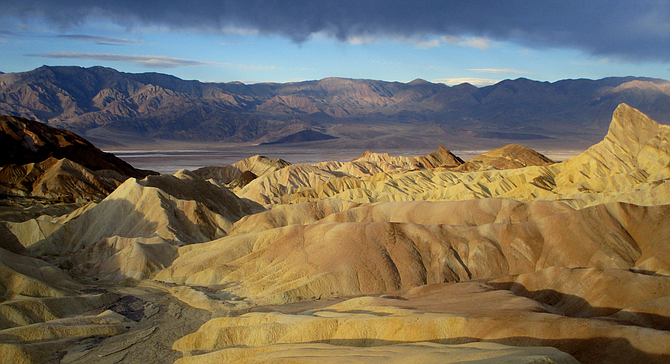
A visit to Death Valley can be a wonderful opportunity to clear your mind of some of the mental clutter we accrue in our daily routines and enjoy a digital detox while soaking in some gorgeous desert scenery.
It's about a five-hour drive from San Diego, making it a feasible long weekend trip. The best time to visit Death Valley is in the winter, late autumn or early spring. For my taste, the area is simply too hot and dry in the summer. But it is doable if that’s the only time you’re able to go. Take precautions, though: in July 1913, the temperature once hit 134 degrees F, the world-record hottest air temperature.
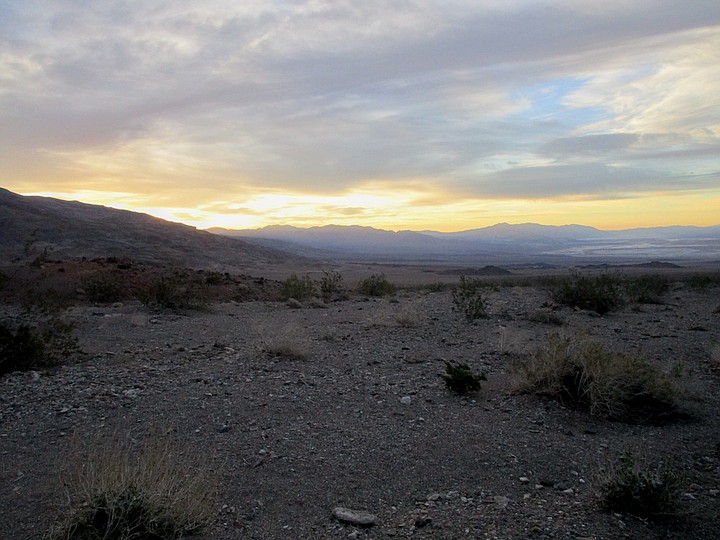
If you're skeptical of making the trek to this desert landscape, you might be pleasantly surprised at what it has to offer.
At 3.4 million acres, Death Valley is the largest national park in the contiguous 48 states, offering a striking variety of physical features: colorful rocks, exquisite sand dunes, jaw-dropping rock formations and breathtaking overlooks. And a superbloom of wildflowers is happening now – the first since 2005 – because of El Niño showers, so you may see an explosion of color to add to the delight of photographers. (Go soon, though! It's only expected to last a few more weeks.)
My first full day in Death Valley, I woke up before dawn to catch the sunrise over the desert. The orange sky and light falling over the flat landscape provided a profound stillness and a magical, transcendent few moments.
After admiring the sunrise, I headed straight to Zabriskie Point. The previous afternoon, after driving into the park, Zabriskie Point was my first stop. I was impressed by the fall of afternoon light over some of the most striking and unusual rock formations I had ever seen, creating a golden tapestry. I wanted to return there soon after dawn for the play of early morning light over the rocks and surrounding canyons and badlands. To my surprise, I was alone when I arrived – quite a contrast to the previous afternoon when the area was crawling with visitors.
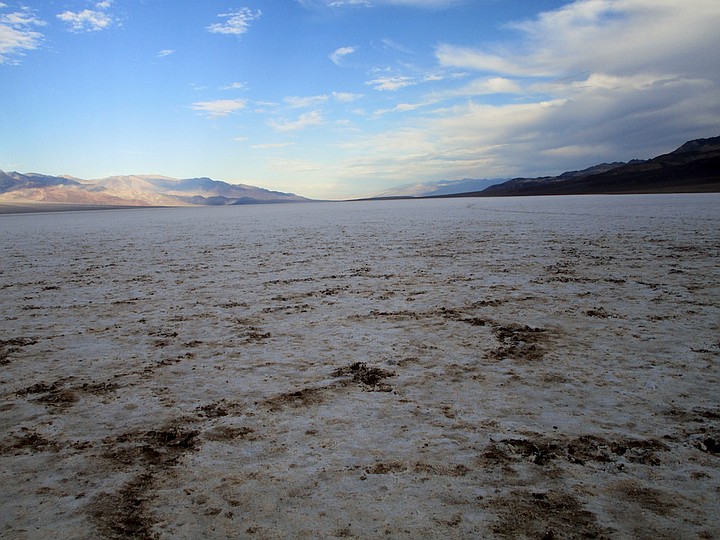
My next stop was the Badwater Basin. At 282 feet below sea level, it’s the lowest and hottest place in the U.S. The salt flats (mixed with sand, gravel and silt) formed by erosion of the surrounding mountains reveal a desolate and expansive vista that I found exhilarating. To fully appreciate the atmosphere, it’s best to get here early to beat the heat and the crowds. If you’re up for an extreme challenge, the Badwater Ultramarathon, billed as “the world’s toughest foot race,” is a 135-mile race beginning here and ending at Whitney Portal, the trailhead to Mount Whitney.
When is the race held? Mid-July, of course. No wimps allowed!
Don’t miss Artist’s Drive on a winding, scenic one-way road off the main highway. Stop off at the Artist’s Palette and enjoy an unusual mélange of colors on the rocks, formed by oxidation of the eroded clay deposits.
One of my favorite spots at Death Valley is the Mesquite Dunes, where you can traverse a somewhat otherworldly sandy terrain. It doesn’t particularly matter when you come here. The dunes are tantalizingly photogenic any hour of the day.
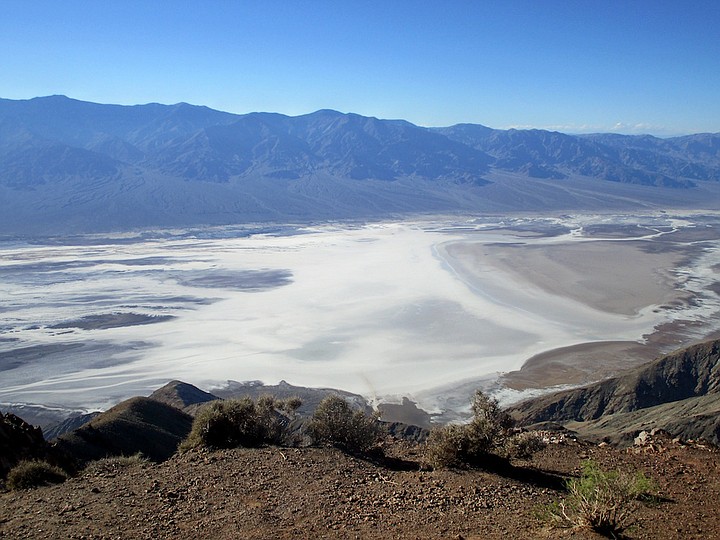
If panoramic views are your thing, drive up to Dante’s View for an overview of the salt flats and an expansive view of Death Valley.
Photographers may also want to head out to the Rhyolite ghost town. Shells of century-old buildings are evocative of a lost era and inspire you to investigate the past of this once-booming town. Rhyolite is near the park's eastern entrance.
Because of repairs due to recent flooding in the area, Scotty’s Castle was closed during my visit. This is considered one of the must-see spots here, particularly for architecture buffs. Walter E. Scott was an eccentric gold prospector and story teller who persuaded his wealthy buddy in Chicago, Albert Johnson, to fund his whimsical and decorative castle in the 1920s. At 3,000 feet above sea level, it’s quite cooler here than on the valley floor.
Some other spots of interest in Death Valley that are worth a look include Uhebe Crater, the Devil’s Golf Course, the Natural Bridge, and Titus Canyon, known as the “Narrows of the Desert.”
Native Americans, particularly the Shoshone, found ways to adapt to the dry conditions and survive here. Evidence of their presence is revealed through artifacts and artwork on rocks dating back nearly 10,000 years.
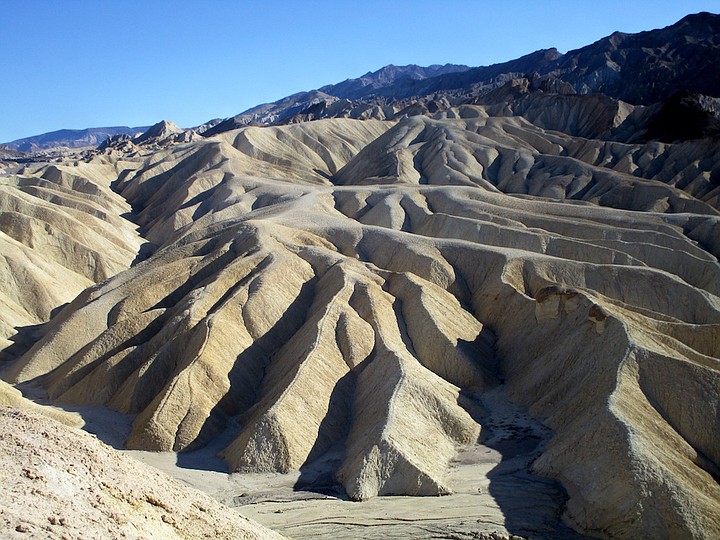
There are several hikes to choose from in Death Valley. Some are more well-traveled than others, so gauge your interest in trekking alongside strangers before choosing your hikes. Bring plenty of water – no matter the weather conditions. This is especially important if you’re traveling alone. I also recommend bringing snacks, sunscreen, a hat, and a first aid kit. On the west side of Death Valley, 9,000-foot Wildrose Peak in the Panamint Mountains provides a scenic 8.4-mile hike at cooler temperatures.
Death Valley is most inspiring at dawn and dusk. I highly recommended getting up before dawn to catch the sunrise over the desert. If you enjoy taking photos, plan your schedule carefully for these prime moments. You won’t regret it! Those seeking silence and solitude will particularly appreciate these early moments in the day.
The best way to experience Death Valley is to camp. There are nine campgrounds available. The Furnace Creek campground is the most popular; it offers most camp amenities with the exception of showers. A mere $5, however, provides access to the pool and showers at Furnace Creek Inn. Death Valley offers four in-park lodging facilities for those that prefer their lodgings indoors. The aforementioned Furnace Creek Inn is the most well-known and popular spot, but rooms are a bit pricey, ranging between $250-$350.
Death Valley got its name because of a gold prospector who died while traveling through here on a covered wagon during the Gold Rush years. “Goodbye, Death Valley,” one of the family members of the dead party is rumored to have said upon leaving the region.
You won’t have to slog there on a covered wagon, but it’s a good idea to have your car checked over before you come. Cell phone service is spotty, and Death Valley can still be dangerous if you wander off on a long hike without sufficient water or have a car break down on a deserted stretch of road.
That said, if you prepare and bring the proper supplies, you might well have an exhilarating and transcendent experience here.


A visit to Death Valley can be a wonderful opportunity to clear your mind of some of the mental clutter we accrue in our daily routines and enjoy a digital detox while soaking in some gorgeous desert scenery.
It's about a five-hour drive from San Diego, making it a feasible long weekend trip. The best time to visit Death Valley is in the winter, late autumn or early spring. For my taste, the area is simply too hot and dry in the summer. But it is doable if that’s the only time you’re able to go. Take precautions, though: in July 1913, the temperature once hit 134 degrees F, the world-record hottest air temperature.

If you're skeptical of making the trek to this desert landscape, you might be pleasantly surprised at what it has to offer.
At 3.4 million acres, Death Valley is the largest national park in the contiguous 48 states, offering a striking variety of physical features: colorful rocks, exquisite sand dunes, jaw-dropping rock formations and breathtaking overlooks. And a superbloom of wildflowers is happening now – the first since 2005 – because of El Niño showers, so you may see an explosion of color to add to the delight of photographers. (Go soon, though! It's only expected to last a few more weeks.)
My first full day in Death Valley, I woke up before dawn to catch the sunrise over the desert. The orange sky and light falling over the flat landscape provided a profound stillness and a magical, transcendent few moments.
After admiring the sunrise, I headed straight to Zabriskie Point. The previous afternoon, after driving into the park, Zabriskie Point was my first stop. I was impressed by the fall of afternoon light over some of the most striking and unusual rock formations I had ever seen, creating a golden tapestry. I wanted to return there soon after dawn for the play of early morning light over the rocks and surrounding canyons and badlands. To my surprise, I was alone when I arrived – quite a contrast to the previous afternoon when the area was crawling with visitors.

My next stop was the Badwater Basin. At 282 feet below sea level, it’s the lowest and hottest place in the U.S. The salt flats (mixed with sand, gravel and silt) formed by erosion of the surrounding mountains reveal a desolate and expansive vista that I found exhilarating. To fully appreciate the atmosphere, it’s best to get here early to beat the heat and the crowds. If you’re up for an extreme challenge, the Badwater Ultramarathon, billed as “the world’s toughest foot race,” is a 135-mile race beginning here and ending at Whitney Portal, the trailhead to Mount Whitney.
When is the race held? Mid-July, of course. No wimps allowed!
Don’t miss Artist’s Drive on a winding, scenic one-way road off the main highway. Stop off at the Artist’s Palette and enjoy an unusual mélange of colors on the rocks, formed by oxidation of the eroded clay deposits.
One of my favorite spots at Death Valley is the Mesquite Dunes, where you can traverse a somewhat otherworldly sandy terrain. It doesn’t particularly matter when you come here. The dunes are tantalizingly photogenic any hour of the day.

If panoramic views are your thing, drive up to Dante’s View for an overview of the salt flats and an expansive view of Death Valley.
Photographers may also want to head out to the Rhyolite ghost town. Shells of century-old buildings are evocative of a lost era and inspire you to investigate the past of this once-booming town. Rhyolite is near the park's eastern entrance.
Because of repairs due to recent flooding in the area, Scotty’s Castle was closed during my visit. This is considered one of the must-see spots here, particularly for architecture buffs. Walter E. Scott was an eccentric gold prospector and story teller who persuaded his wealthy buddy in Chicago, Albert Johnson, to fund his whimsical and decorative castle in the 1920s. At 3,000 feet above sea level, it’s quite cooler here than on the valley floor.
Some other spots of interest in Death Valley that are worth a look include Uhebe Crater, the Devil’s Golf Course, the Natural Bridge, and Titus Canyon, known as the “Narrows of the Desert.”
Native Americans, particularly the Shoshone, found ways to adapt to the dry conditions and survive here. Evidence of their presence is revealed through artifacts and artwork on rocks dating back nearly 10,000 years.

There are several hikes to choose from in Death Valley. Some are more well-traveled than others, so gauge your interest in trekking alongside strangers before choosing your hikes. Bring plenty of water – no matter the weather conditions. This is especially important if you’re traveling alone. I also recommend bringing snacks, sunscreen, a hat, and a first aid kit. On the west side of Death Valley, 9,000-foot Wildrose Peak in the Panamint Mountains provides a scenic 8.4-mile hike at cooler temperatures.
Death Valley is most inspiring at dawn and dusk. I highly recommended getting up before dawn to catch the sunrise over the desert. If you enjoy taking photos, plan your schedule carefully for these prime moments. You won’t regret it! Those seeking silence and solitude will particularly appreciate these early moments in the day.
The best way to experience Death Valley is to camp. There are nine campgrounds available. The Furnace Creek campground is the most popular; it offers most camp amenities with the exception of showers. A mere $5, however, provides access to the pool and showers at Furnace Creek Inn. Death Valley offers four in-park lodging facilities for those that prefer their lodgings indoors. The aforementioned Furnace Creek Inn is the most well-known and popular spot, but rooms are a bit pricey, ranging between $250-$350.
Death Valley got its name because of a gold prospector who died while traveling through here on a covered wagon during the Gold Rush years. “Goodbye, Death Valley,” one of the family members of the dead party is rumored to have said upon leaving the region.
You won’t have to slog there on a covered wagon, but it’s a good idea to have your car checked over before you come. Cell phone service is spotty, and Death Valley can still be dangerous if you wander off on a long hike without sufficient water or have a car break down on a deserted stretch of road.
That said, if you prepare and bring the proper supplies, you might well have an exhilarating and transcendent experience here.
Comments